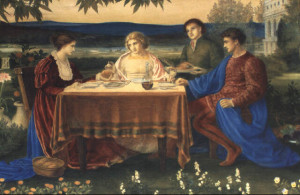It’s the first leap year since the inception of the Convivio Book of Days blog, and late last week the prospect of researching and writing about leap year was getting me excited. Once I began, however, I found it didn’t really interest me all that much. I couldn’t figure out why I was so disinterested… until the word “rational” popped up in one of the books I was reading. Don’t get me wrong; I love rational things, especially when it comes to science and politics. But “rational,” in terms of the seasonal round of the year, well… it’s just not a word I was pining for in this case.
The fact is that leap year is indeed quite rational. In the Gregorian calendar, which is the calendar we use now to measure our days, leap year is a necessary thing set in place to keep the calendar aligned with the seasons. Were it not for leap year, things would get a bit wonky over time. This is because our planet’s trip around the sun, which equals a year, is not exactly 365 days. It’s more like 365 and a quarter days… and so every four years we add an extra day to February, just to balance things out. But even this is not super accurate, for it actually takes the Earth 365 days, 5 hours, 48 minutes and 46 seconds to make that revolution around the sun. To compensate for this, there are some years that you might think would be leap but, in fact, are not. Century years––years ending in 00––are never leap… unless they are divisible by 400. And so while 2000 was a leap year, 1900 was not. All of this just to make sure that our calendar remains in sync with the seasons. Which was definitely not the case when advisors to Pope Gregory XIII devised our current calendar in 1582. Gregory’s concerns had to do with the observation of Easter, which is a moveable feast based on the lunar cycle and the spring equinox. By 1582, after centuries of following the Julian calendar, the spring equinox was falling on the 11th of March, ten days earlier than it should, and this was throwing off the proper timing for Easter.
And so by proclamation of Pope Gregory XIII, ten days were removed from the calendar. The day after October 4, 1582 was October 15, 1582, and from that day on, the Gregorian calendar, with its system of leap years, was the calendar used in the Roman Catholic world. Eventually it became the calendar adopted by the world at large.
Of course I have inadvertently done what I said I wasn’t interested in doing: I’ve given you the rationale behind leap year. But I guess the rational part of the story is necessary for giving you the part of the story that does, in fact, interest me. As important as Pope Gregory’s reforms were, keep in mind when all this is happening: 1582. It is the century of the Protestant Reformation. Anything decreed by Rome was suspect in the Protestant countries, and there was no way some pope was going to erase ten days from anyone’s calendar, especially in England and her colonies. In their obstinance against things Popish, the United Colonies and Mother England did not adopt the new calendar until 1752: one hundred seventy years later, and by then it was necessary to drop eleven days. The same act of Parliament that switched Great Britain to the Gregorian calendar also moved New Year’s Day to January 1, which, up until then, was celebrated on March 25.
Wait, what? March 25 as New Year’s Day? Here’s where things, to me at least, get really interesting. March 25 is Lady Day: the Feast of the Annunciation… we are, on this day, nine months to the Nativity. It is the day when the angel Gabriel is said to have visited Mary to announce to her that she would bear a son, the son of God. Christmas, and connexions to Christmas, have ways of popping up throughout the traditional seasonal round of the year, and here is this one at the height of spring. And while New Year’s Day celebrations on the First of January go back to Yuletide celebrations in England from at least the 14th century, the official start of the year had been March 25.
To this day we use the letters A.D. after the year, as in, This chapter of the Convivio Book of Days was published February 29, 2016 A.D. The letters stand for Anno Domini, Latin for “in the year of the Lord.” This system had an inventor, of course, and his name was Dionysius Exiguus. He introduced the concept in the year 525. And when Exiguus introduced his system, he also assigned the date March 25 as the beginning of the new year, for the age of grace, according to the doctrines of the Church, began with the Annunciation, when Jesus Christ is believed to have been conceived by the Holy Spirit in Mary.
This Feast of the Annunciation came to be known as Lady Day, still celebrated to this day. You’ve heard me speak of “cross quarter days” in past chapters of the Book of Days; well, Lady Day is one of the quarter days. It is one of four quarter days of the year, all of which fall near celestially auspicious times: Christmas comes with midwinter (the winter solstice); St. John’s Day comes with midsummer (the summer solstice); Michaelmas, the Feast of St. Michael, comes with the autumnal equinox; and here is Lady Day, coming on the heels of the vernal equinox. The quarter days have long marked the divisions of the fiscal year in England.
There are stories of riots in the United Colonies when Parliament took those eleven days from folks in September 1752, but this may by now be the stuff of legend. What we can surmise is that it was certainly a matter worth talking about. These were the days of Benjamin Franklin’s Poor Richard’s Almanack, and in that rag, Mr. Franklin helped his readers see the good of all this “Popish nonsense:”
Be not astonished, nor look with scorn, dear reader, at such a deduction of days, nor regret as for the loss of so much time, but take this for your consolation, that your expenses will appear lighter and your mind be more at ease. And what an indulgence is here, for those who love their pillow to lie down in peace on the second of this month and not perhaps awake till the morning of the fourteenth.
If all this leaves your mind a muddled mess, I get it, I’m right there with you. It is the great soup of these matters that bring about all sorts of calendrical confusion that have to do with historical dates Old Style and New Style, with Christmas celebrated by some on December 25 and others on January 6, with differences between Roman and Greek Orthodox calendars, with uncertainties about dates amongst those who count family genealogy as a hobby. It all becomes a great muddled mess. And if I’ve made your head hurt with all this information, it is all because of the fact that today is Leap Year. Lucky for you it comes only once each four years. (Except for century years, of course. Unless they are divisible by 4. Oh and don’t forget the most recent adjustment: we are now limiting future century leap years to those divisible by 900 and which have a remainder of 200 or 600. Sorry. Again, all that rational stuff.)
Guess what? There are traditions associated with Leap Year. They have to do mostly with marriage. Leap Year has long been considered a day when it is acceptable for women to propose marriage to men. Should a man refuse an offer of marriage on the 29th of February, he was traditionally obligated to buy gloves for the woman he refused. This, to hide the hand that has no ring upon it. Thankfully, we are living in more equitable times now and I highly advise leaving some traditions behind. Ask. Ask whenever you wish.


